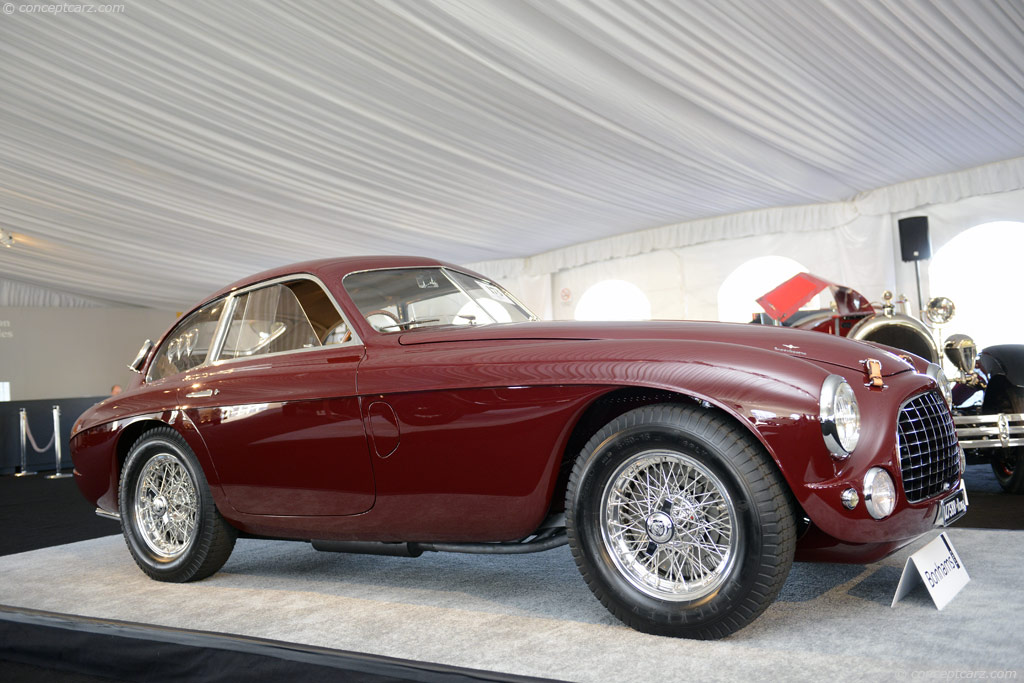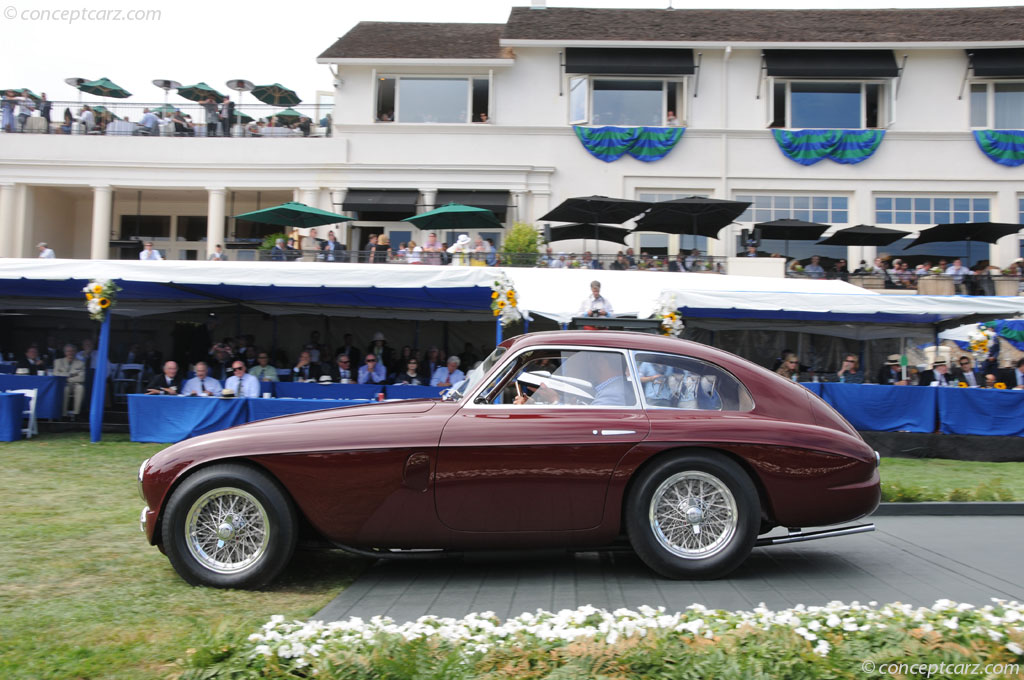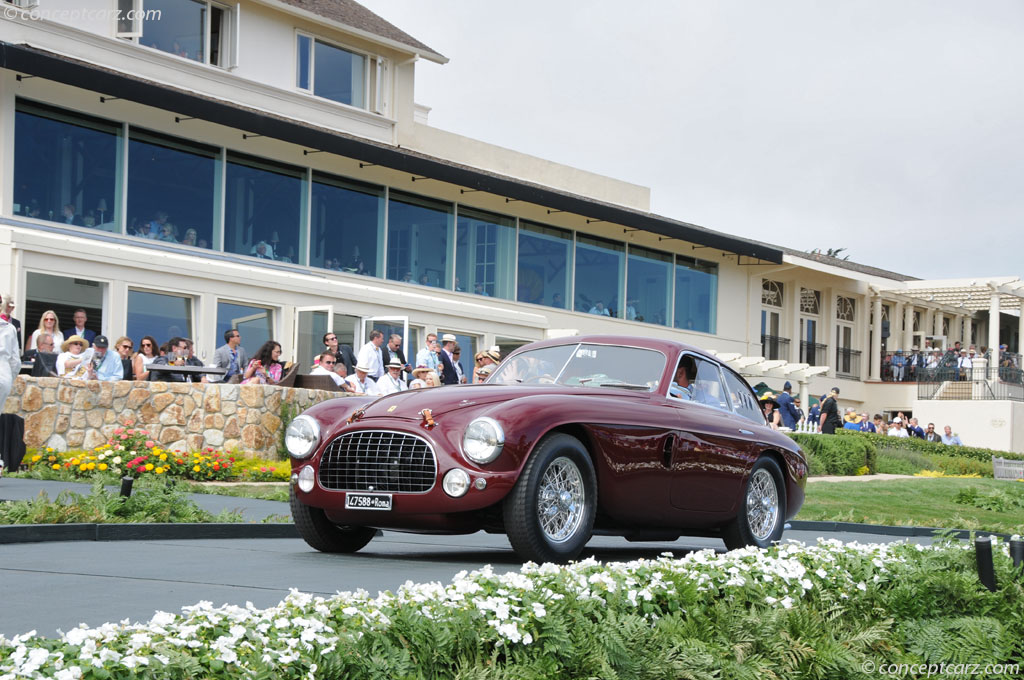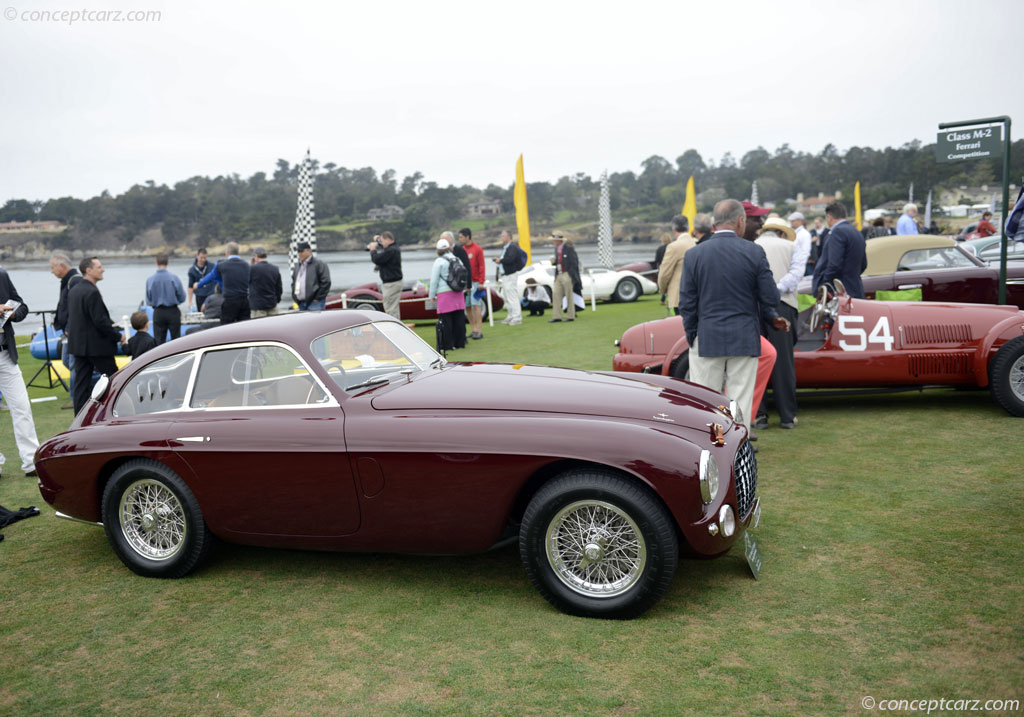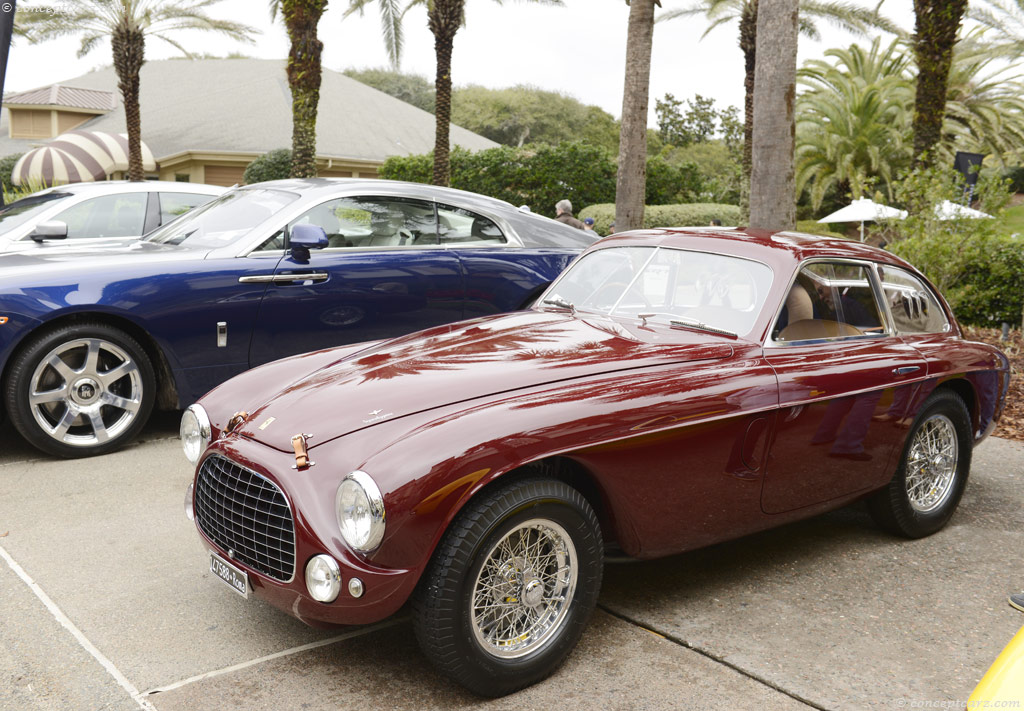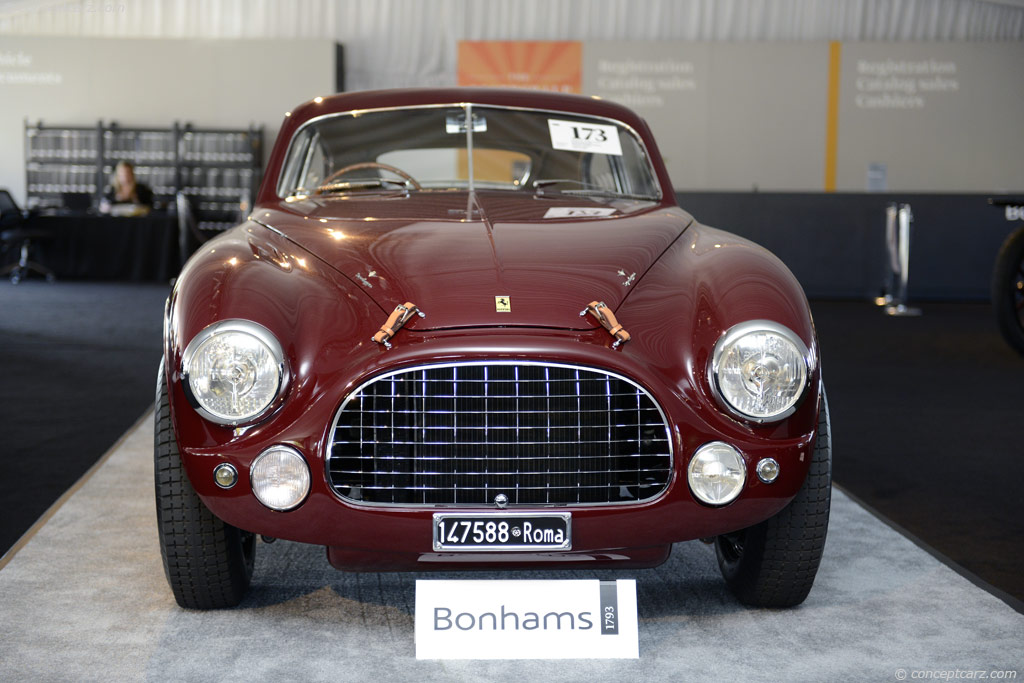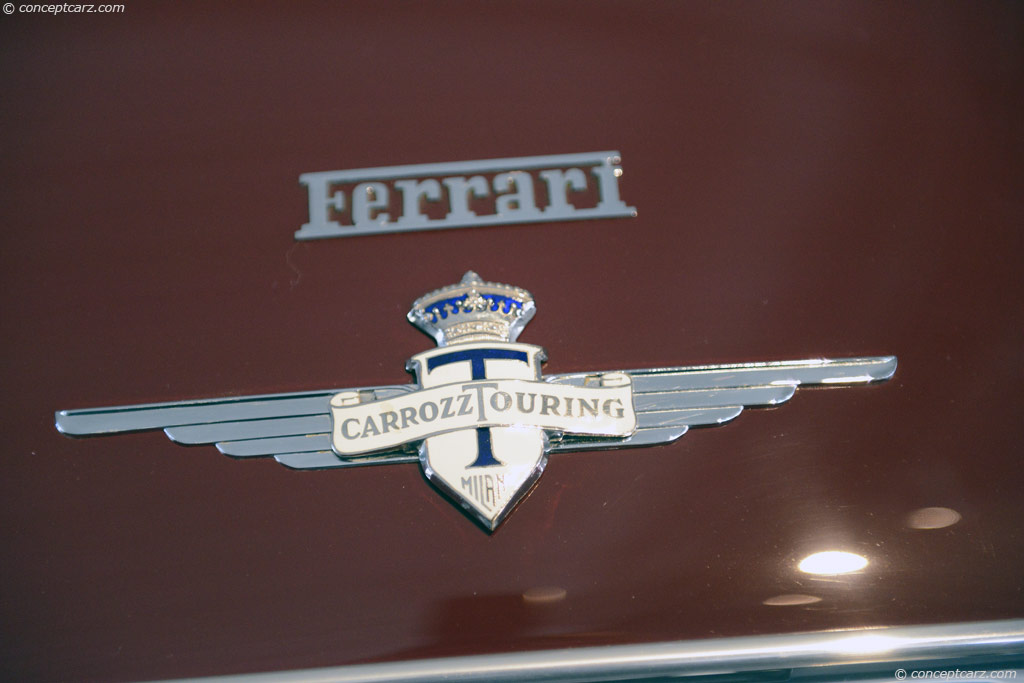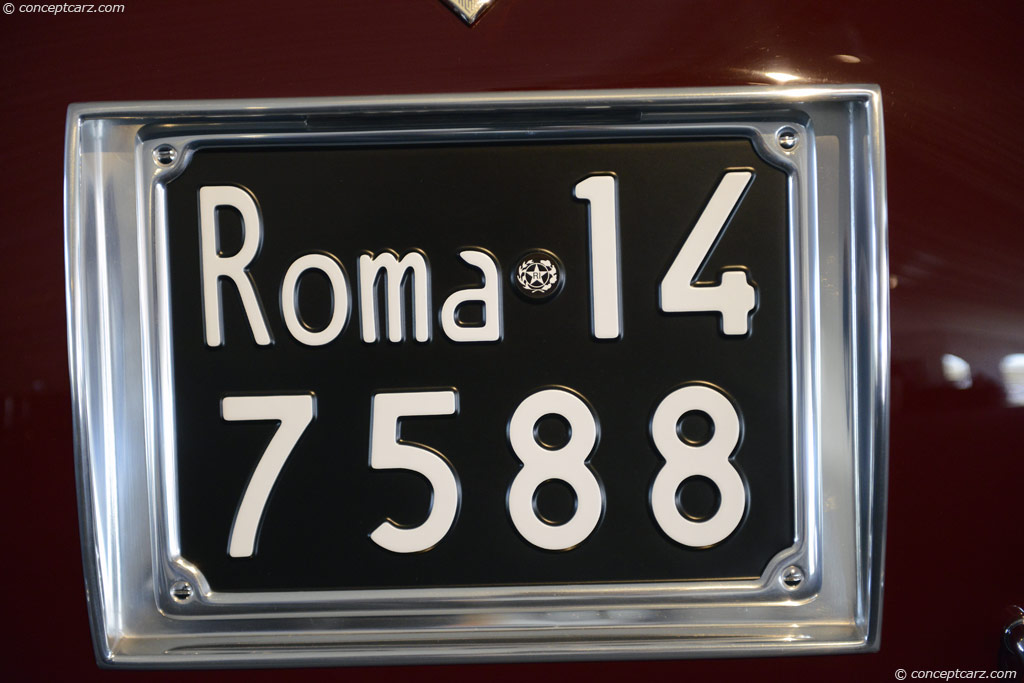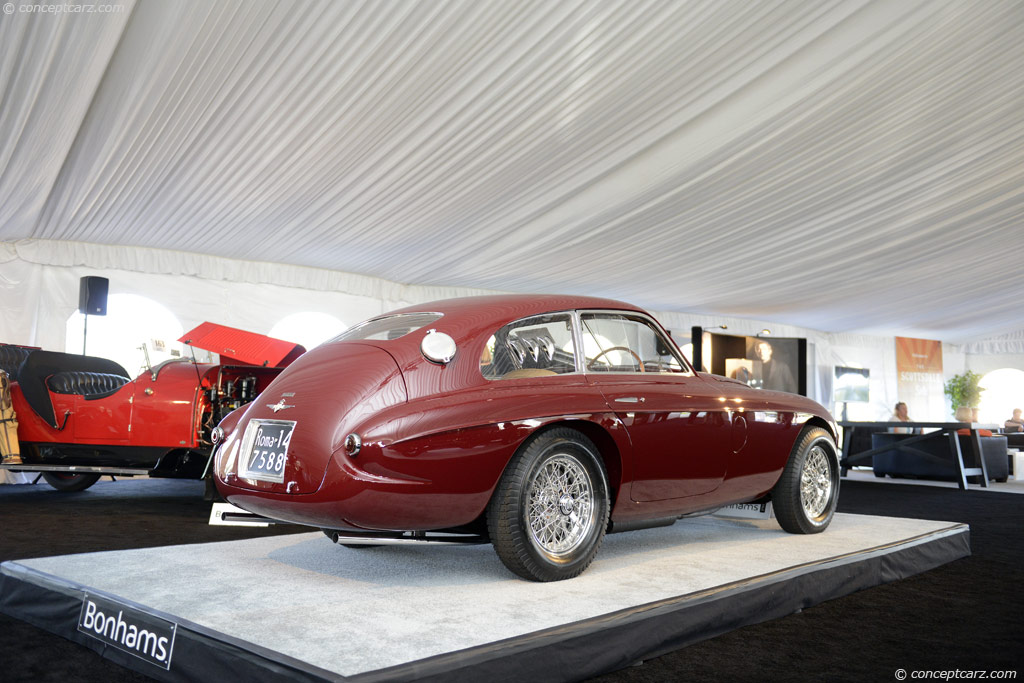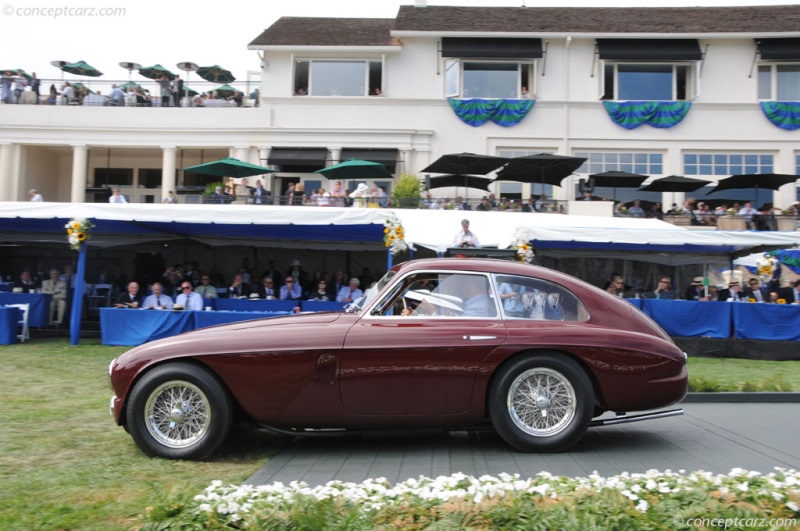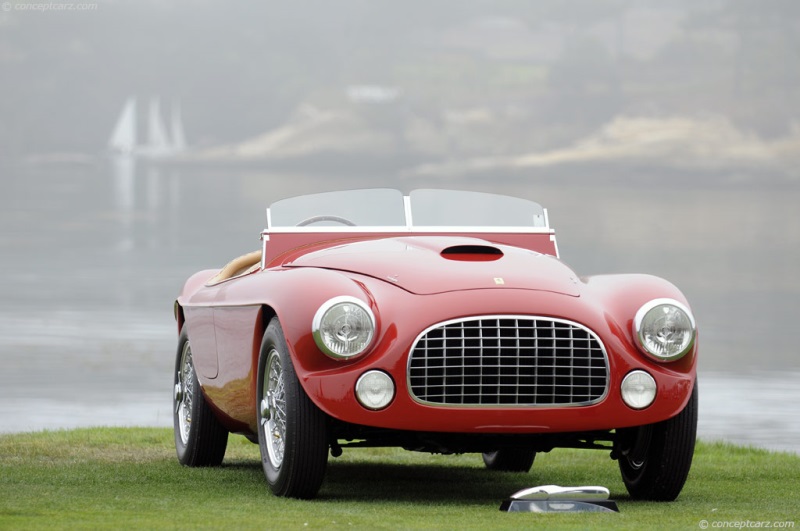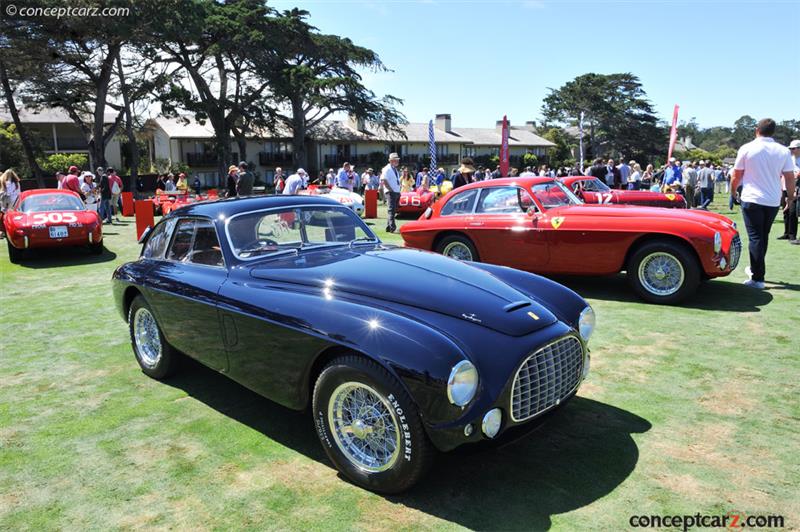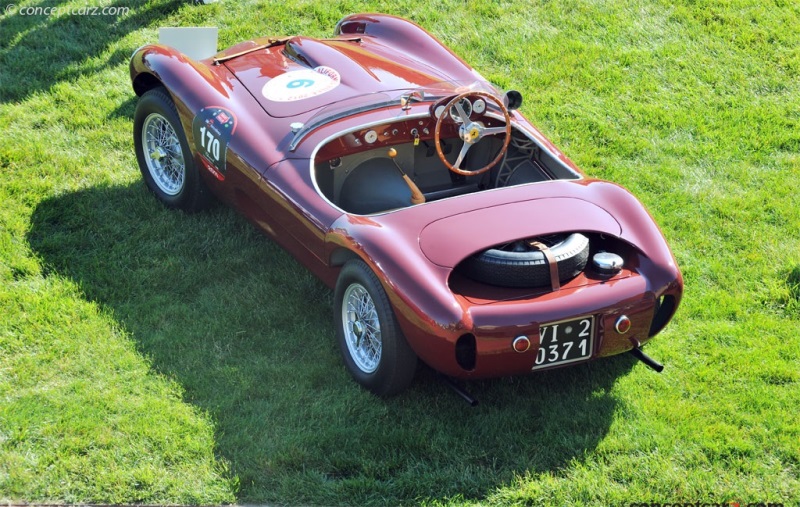Image credit: © conceptcarz.com (Reproduction Or reuse prohibited).
Ferrari's numbering system for their cars reserved odd numbers for road going chassis while the even numbers were destined for racing and competition cars. This number system dates back to the company's second-ever model, the 166 Spyder Corsa of late 1947. The cars had cycle-wing fenders and powered by a Gioacchino Colombo-designed short block V12. They began with chassis numbers 002C and 004C. By the end of the 166 Spyder Corsa run, the C suffix had been changed to I, in preparation of the Inter designation.
The performance variant of the 166 was initially called the 166 Sport and later moved into the competition-prepared 166 MM. The 166 MM is perhaps just as notable for formally introducing the even-number system for racing sports cars. These began with 0002M, while odd-numbered road cars evolved from 007S with the first 166 Inter (street).
The 'Sport' nomenclature was later changed to Export and reflects the company's long planned courtship of the overseas market, especially American racing privateers.
The Touring-bodied Ferraris, with their lightweight Superleggera construction technique, were some of the more successful early racing Berlinettas for the company. They featured loosely fitting aluminum skins over a tube-frame chassis.
As Ferrari initiated road car production with the 166, the first-ever Ferrari Berlinetta appeared at the 1948 Mille Miglia on chassis no. 003S, wearing coachwork by Allemano. At the Turin Motor Show in late 1948, it was Touring that presented two new Ferrari 166 examples, an open car and a closed 4-seat berlinetta. The closed car, chassis no. 005S, was the first Ferrari berlinetta built by Touring. Chassis number 0026M was showcase a design that had evolved into the Le Mans Berlinetta fastback that would characterize the coachbuilder's closed-body design through the next several Ferrari models, ending with the 212 Export.
Five examples of the 166 MM Touring Berlientta were produced before the engine was bored to 212 specifications. This particular example, 0088 E, is the first of just four more such bodies that were mounted on the even-number, competition 212 platform. It is the seventh overall 212 Export constructed and was given Touring body number 3273, engine internal no. 16/E and gearbox no. 20/E. The frame was finished on January 26th of 1961, with the rear axle assembly finished on February 14th. The engine was completed two days later, complete with the three Weber carburetor setup, revised competition cam-timing and valve arrangement, and was tuned for sports racing use.
On February 23, a certificate of origin was issued and a day later the car was test driven at the factory. The car was then sent to Rome-based dealer Mambretti Sonzogni and was sold new on April 20th of 1951, to Augusto Caraceni.
During September 1951, the car was entered by Mr. Caraceni at the fifth annual Stella Alpina-Hillclimb, and given racing number 254. It finished 5th overall and 2nd in class. Early in 1952, the car was sold to its second owner of record, Count Antonio Naselli of Trevinano-Viterbo. Less than a month later, it was entered in the XII Giro di Sicilia wearing #357. On August 28th, it returned again to the Stella-Alpina Hillclimb. In the spring of 1954, the car was sold to Dino Vaselli of Rome. On September 8th, it was sold to Giampaolo Terigi of Lucca. A year later, it entered the care of its fifth owner, Roberto Federici of Rome, who in turn sold it to Mrs. Rosetta Maiavacca of Genova four months later. In January 1957, the 212 was acquired by Genovese resident Luigi Danuzzo, who sold the car eighteen months later to its final Italian owner, Enrico Ghezzi of Milan.
In the early 1960s, the car was sent across the Atlantic to and to the United States through Italian dealer Michele Vernola. By 1963, the car had been acquired by Lowell Musick of Long Beach, California. The current owner acquired the car in 1969 from Mr. Musick. Since that period, it has spent some of its time in a controlled state of storage, still retaining its original matching-numbers drivetrain and complete original Touring Berlinetta coachwork. In 2008, a complete restoration was begun. The work cost approximately $600,000.By Daniel Vaughan | Jan 2014
The performance variant of the 166 was initially called the 166 Sport and later moved into the competition-prepared 166 MM. The 166 MM is perhaps just as notable for formally introducing the even-number system for racing sports cars. These began with 0002M, while odd-numbered road cars evolved from 007S with the first 166 Inter (street).
The 'Sport' nomenclature was later changed to Export and reflects the company's long planned courtship of the overseas market, especially American racing privateers.
The Touring-bodied Ferraris, with their lightweight Superleggera construction technique, were some of the more successful early racing Berlinettas for the company. They featured loosely fitting aluminum skins over a tube-frame chassis.
As Ferrari initiated road car production with the 166, the first-ever Ferrari Berlinetta appeared at the 1948 Mille Miglia on chassis no. 003S, wearing coachwork by Allemano. At the Turin Motor Show in late 1948, it was Touring that presented two new Ferrari 166 examples, an open car and a closed 4-seat berlinetta. The closed car, chassis no. 005S, was the first Ferrari berlinetta built by Touring. Chassis number 0026M was showcase a design that had evolved into the Le Mans Berlinetta fastback that would characterize the coachbuilder's closed-body design through the next several Ferrari models, ending with the 212 Export.
Five examples of the 166 MM Touring Berlientta were produced before the engine was bored to 212 specifications. This particular example, 0088 E, is the first of just four more such bodies that were mounted on the even-number, competition 212 platform. It is the seventh overall 212 Export constructed and was given Touring body number 3273, engine internal no. 16/E and gearbox no. 20/E. The frame was finished on January 26th of 1961, with the rear axle assembly finished on February 14th. The engine was completed two days later, complete with the three Weber carburetor setup, revised competition cam-timing and valve arrangement, and was tuned for sports racing use.
On February 23, a certificate of origin was issued and a day later the car was test driven at the factory. The car was then sent to Rome-based dealer Mambretti Sonzogni and was sold new on April 20th of 1951, to Augusto Caraceni.
During September 1951, the car was entered by Mr. Caraceni at the fifth annual Stella Alpina-Hillclimb, and given racing number 254. It finished 5th overall and 2nd in class. Early in 1952, the car was sold to its second owner of record, Count Antonio Naselli of Trevinano-Viterbo. Less than a month later, it was entered in the XII Giro di Sicilia wearing #357. On August 28th, it returned again to the Stella-Alpina Hillclimb. In the spring of 1954, the car was sold to Dino Vaselli of Rome. On September 8th, it was sold to Giampaolo Terigi of Lucca. A year later, it entered the care of its fifth owner, Roberto Federici of Rome, who in turn sold it to Mrs. Rosetta Maiavacca of Genova four months later. In January 1957, the 212 was acquired by Genovese resident Luigi Danuzzo, who sold the car eighteen months later to its final Italian owner, Enrico Ghezzi of Milan.
In the early 1960s, the car was sent across the Atlantic to and to the United States through Italian dealer Michele Vernola. By 1963, the car had been acquired by Lowell Musick of Long Beach, California. The current owner acquired the car in 1969 from Mr. Musick. Since that period, it has spent some of its time in a controlled state of storage, still retaining its original matching-numbers drivetrain and complete original Touring Berlinetta coachwork. In 2008, a complete restoration was begun. The work cost approximately $600,000.By Daniel Vaughan | Jan 2014
Ferrari had found the car it had been looking for in the 166. Not only was it the perfect car for the track, but it also introduced the Ferrari name to the customer as well. It was a great car, but in Enzo's relentless pursuit for perfection and never standing still, it could be made better. This pursuit would lead to the 195 and then to the next model that made its debut in 1951—the 212.
The heart of the 212 remained the Colombo V12 that had been used in the 166. This engine would first be designed back in 1946 and would be naturally evolved throughout the years. This would be demonstrated by the fact the engine's original displacement of 1.5-liters would be increased to 2. The result of the increase in engine displacement would be victories in the 24 Hours of Le Mans and in the arduous Mille Miglia. So, the reliability and durability of the Colombo engine was more than adequately demonstrated. There was no reason to depart from the basic concept then.
The engine was just about everything to Enzo. In fact, he would put much more emphasis on the engine than any other component on the car. This is why the 195 would be practically the 166, just with a 2.3-liter Colombo engine.
To offset the racing program models of the racing cars would be built for road-going purposes. This was quite popular for, despite the fact the engines would be de-tuned slightly, customers would still have the opportunity to experience nearly the same kind of rush as the professionals. This tradition would continue with Ferrari's next iteration.
Although Pininfarina is the coachbuilder most closely associated with Ferrari, Carrozzeria Touring of Milan would be one of the first to make the prancing horse brand so famous. Touring would make a simple, yet elegant, example of the 166MM. The coachbuilder would also be involved in designing some other memorable automobiles during the early years of Ferrari. Therefore, it would be of little surprise, in the early 1950s, that Touring would be commissioned right along with Pininfarina, Vignale and Ghia to produce bodies for the evolution of the 195. However, Touring's involvement in the 212 would be of a lesser number than that of the 166 program. In the case of the 166, Touring was widely involved, almost undertaking the project all by itself. By the time the 212 came around, Touring would find itself in the minority.
Once again, the new 212 would not be much different from the 166 or the 195 that came before. The body designs by Touring and the others would not vary a whole lot. The chassis was still comprised of tubular framing, albeit with slightly smaller diameter tubing. The chassis was, on a whole, slightly lighter and rigid. However, the suspension, front and rear, remained unchanged. Even the body styling would be virtually the same with the exception, in Touring's case, of minor revisions made to soften the lines of the nose and other little minor details.
As usual, Ferrari would make the only major difference between the 195 and 212 be the engine. The Colombo V12 remained but it would be increased in size from 2.3-liters to 2.6-liters. Ferrari would take the increased engine and make it and the updated chassis the basis of two possible examples. One example would be built for road-going purposes and it would be known as the Inter. Then, of course, there would be a competition model built. However, instead of 'Sport' the competition example would be known as the 'Export' signifying Enzo's intent to expand into foreign markets.
When Touring built their first examples of the 166 they would build two examples. One would become the famous Barchetta. They would also create a closed-top Berlinetta that could seat four. This would be the first Berlinetta ever built by Touring for Ferrari. Its 212 Export Berlinetta would end up being its last.
The 212 Inter would have the same Colombo V12 powering it and it would achieve a respectable 150hp. The Export model could be upgraded with an engine of higher compression and three Weber carburetors boosting power up to 170hp. When combined with its shorter wheelbase, the 212 Export became a very able competitor.
In total, just 27 examples of the Export would be built by all of the coachbuilders. Touring's example of the 212 Export would be far less. And even amongst those very few there would be some that would take on an even greater meaning. One of those is chassis 0088 E.
The engine, to Ferrari, was everything. Therefore, there would be a very short time period between the 166 and the 212, especially in Touring's case. Touring's 166 Barchetta was by far its most popular model of the 166. Still, the company would build a few examples of its Berlinetta body style for the 166. However, Touring would have less than a dozen examples of the Berlinetta built before the engine would be increased in size to 212 specifications. Therefore, even though Touring were still building bodies for the 166, the engine had already been increased in size, which meant the chassis was either going to be a 195 or a 212.
Touring wasn't about to throw its work away. Therefore, when chassis 0088 E rolled into the coachbuilder's factory in Milan, a special marriage would take place. Chassis 0088 E was just the seventh 212 Export chassis Ferrari had produced. Touring would set about taking its Berlinetta body, originally intended for the 166 chassis, and would fit it to the newer 212 short wheelbase chassis. The body number was 3473.
The frame and drivetrain would all be completed by the middle of February in 1951. By the end of the month the Touring Berlinetta body had been fitted and the car was test driven to ensure everything worked properly. It was the seventh 212 Export and it was one of just four to ever receive one of the Berlinetta bodies originally intended for the 166 chassis.
This exceptional 212 Export would be sold through Mambretti Sonzogni to Augusto Caraceni in April of 1951. Caraceni may have had a rather docile career as one of Italy's most famous tailors, but he had one very exciting and dangerous passion. The son of the man considered the father of modern Italian tailoring, Augusto had corse blood coursing through his veins. And so, he would take the new 212 Export for his uses in hill climbs and other racing events. By September of that year, Caraceni had completed the Stella Alpina Hillclimb 5th overall and 2nd in class.
By February of 1952 Augusto would purchase a second 212 Export, this one bodied by Vignale. He would eventually use this car in the Mille Miglia. Having two 212 Exports, it was time for Caraceni to part with one. And so, 0088 E would be sold some time later to Count Antonio Naselli.
Count Naselli would also compete with the car taking part in the XII Giro di Sicilia and the Stella Alpina Hillclimb once again. Unfortunately, by May of 1954, 0088 E would be on its way to its third owner.
Dino Vaselli lived in Rome and he would end up purchasing the car, but he too would keep it for just a short while before selling it to Giampaolo Terigi. The car would continue to change hands what seemed to be annually, if not less. Then, in 1957, the car would find its way into the hands of Enrico Ghezzi.
In many respects 0088 E would finally come home. Not only would the car remain in the hands with Ghezzi for more than a couple of years, but Enrico also lived in Milan, the same city in which Touring had built the body for the car.
By 1963, 0088 E would be in the United States and with its next owner, Lowell Musick of Long Beach, California. Musick would buy the car through Italian dealer Michele Vernola. Musick certainly understood and appreciated the flowing lines of the Berlinetta given that he was an employee with Douglas Aircraft.
While under Musick's ownership, 0088 E would be given to Charles Betz to have the Berlinetta's motor repaired and tuned. Betz would undertake the work and would have the Ferrari at his home where it was soon to be spotted by its latest owner. The car would be purchased from Musick in 1969, but it would end up in storage for a number of years.
Still, in spite of the fact the 212 Export remained in storage it was of such great quality and originality that it would end up serving as a benchmark for another 166 Berlinetta being restored.
Finally, in 2008, a full restoration of the 212 Export was undertaken. Steve Beckman's Metalworks in Costa Mesa would be given the task to restore the car's body to its original vintage color of Amaranto. Bob Wallace would then be commissioned to work on the Colombo V12. Wallace would take great care in his work but would also take the opportunity to install a limited-slip differential. Other components, such as instruments and the chrome, would be sent to individual experts for restoration. Pete Engel would then be brought into the picture to install new and correct interior upholstery. When the car was completely rebuilt and reassembled the cost of the restoration process would nearly reach $600,000, all of which could be verified by the numerous receipts, documentation and other pieces of information detailing the restoration work.
Exclusive and rare, 0088 E retains and even greater place of exclusivity as it has been isolated from its Ferrari brethren for decades and has not been available for sale for just as long. This is incredibly surprising for a car that changed hands so many times in its early life. A car that seemed so common that it remained but for a short time with its early owners has now become one of the most untouchable.
Offered at the 2014 Bonhams auction in Scottsdale, Arizona, chassis 0088 E would come with its matching engine and bearing its original color. When the bidding concluded, the 1951 Ferrari 212 Export would sell for a price of $3,190,000, inclusive of buyer's premium.
Sources:
'1951 Ferrari 212 Export News, Pictures, Specifications and Information', (http://www.conceptcarz.com/vehicle/z11148/Ferrari-212-Export.aspx). Conceptcarz.com: From Concept to Production. http://www.conceptcarz.com/vehicle/z11148/Ferrari-212-Export.aspx. Retrieved 27 January 2014.
'1950 Ferrari 195 Inter News, Pictures, Specifications and Information', (http://www.conceptcarz.com/vehicle/z13218/Ferrari-195-Inter.aspx). Conceptcarz.com: From Concept to Production. http://www.conceptcarz.com/vehicle/z13218/Ferrari-195-Inter.aspx. Retrieved 27 January 2014.
'Ferrari 212 Export Touring Berlinetta', (http://www.ultimatecarpage.com/car/3778/Ferrari-212-Export-Touring-Berlinetta.html). Ultimatecarpage.com: Powered by Knowledge, Driven by Passion. http://www.ultimatecarpage.com/car/3778/Ferrari-212-Export-Touring-Berlinetta.html. Retrieved 27 January 2014.
'Lot No. 173: 1951 Ferrari 212 Export Berlinetta', (http://www.bonhams.com/auctions/21392/lot/173/#/MR0_page=
18&MR0_length=10&MR0_category=list&k0=173&MR0_currency=USD&m0=0). Bonhams. http://www.bonhams.com/auctions/21392/lot/173/#/MR0_page=
18&MR0_length=10&MR0_category=list&k0=173&MR0_currency=USD&m0=0. Retrieved 27 January 2014.
By Jeremy McMullen
The heart of the 212 remained the Colombo V12 that had been used in the 166. This engine would first be designed back in 1946 and would be naturally evolved throughout the years. This would be demonstrated by the fact the engine's original displacement of 1.5-liters would be increased to 2. The result of the increase in engine displacement would be victories in the 24 Hours of Le Mans and in the arduous Mille Miglia. So, the reliability and durability of the Colombo engine was more than adequately demonstrated. There was no reason to depart from the basic concept then.
The engine was just about everything to Enzo. In fact, he would put much more emphasis on the engine than any other component on the car. This is why the 195 would be practically the 166, just with a 2.3-liter Colombo engine.
To offset the racing program models of the racing cars would be built for road-going purposes. This was quite popular for, despite the fact the engines would be de-tuned slightly, customers would still have the opportunity to experience nearly the same kind of rush as the professionals. This tradition would continue with Ferrari's next iteration.
Although Pininfarina is the coachbuilder most closely associated with Ferrari, Carrozzeria Touring of Milan would be one of the first to make the prancing horse brand so famous. Touring would make a simple, yet elegant, example of the 166MM. The coachbuilder would also be involved in designing some other memorable automobiles during the early years of Ferrari. Therefore, it would be of little surprise, in the early 1950s, that Touring would be commissioned right along with Pininfarina, Vignale and Ghia to produce bodies for the evolution of the 195. However, Touring's involvement in the 212 would be of a lesser number than that of the 166 program. In the case of the 166, Touring was widely involved, almost undertaking the project all by itself. By the time the 212 came around, Touring would find itself in the minority.
Once again, the new 212 would not be much different from the 166 or the 195 that came before. The body designs by Touring and the others would not vary a whole lot. The chassis was still comprised of tubular framing, albeit with slightly smaller diameter tubing. The chassis was, on a whole, slightly lighter and rigid. However, the suspension, front and rear, remained unchanged. Even the body styling would be virtually the same with the exception, in Touring's case, of minor revisions made to soften the lines of the nose and other little minor details.
As usual, Ferrari would make the only major difference between the 195 and 212 be the engine. The Colombo V12 remained but it would be increased in size from 2.3-liters to 2.6-liters. Ferrari would take the increased engine and make it and the updated chassis the basis of two possible examples. One example would be built for road-going purposes and it would be known as the Inter. Then, of course, there would be a competition model built. However, instead of 'Sport' the competition example would be known as the 'Export' signifying Enzo's intent to expand into foreign markets.
When Touring built their first examples of the 166 they would build two examples. One would become the famous Barchetta. They would also create a closed-top Berlinetta that could seat four. This would be the first Berlinetta ever built by Touring for Ferrari. Its 212 Export Berlinetta would end up being its last.
The 212 Inter would have the same Colombo V12 powering it and it would achieve a respectable 150hp. The Export model could be upgraded with an engine of higher compression and three Weber carburetors boosting power up to 170hp. When combined with its shorter wheelbase, the 212 Export became a very able competitor.
In total, just 27 examples of the Export would be built by all of the coachbuilders. Touring's example of the 212 Export would be far less. And even amongst those very few there would be some that would take on an even greater meaning. One of those is chassis 0088 E.
The engine, to Ferrari, was everything. Therefore, there would be a very short time period between the 166 and the 212, especially in Touring's case. Touring's 166 Barchetta was by far its most popular model of the 166. Still, the company would build a few examples of its Berlinetta body style for the 166. However, Touring would have less than a dozen examples of the Berlinetta built before the engine would be increased in size to 212 specifications. Therefore, even though Touring were still building bodies for the 166, the engine had already been increased in size, which meant the chassis was either going to be a 195 or a 212.
Touring wasn't about to throw its work away. Therefore, when chassis 0088 E rolled into the coachbuilder's factory in Milan, a special marriage would take place. Chassis 0088 E was just the seventh 212 Export chassis Ferrari had produced. Touring would set about taking its Berlinetta body, originally intended for the 166 chassis, and would fit it to the newer 212 short wheelbase chassis. The body number was 3473.
The frame and drivetrain would all be completed by the middle of February in 1951. By the end of the month the Touring Berlinetta body had been fitted and the car was test driven to ensure everything worked properly. It was the seventh 212 Export and it was one of just four to ever receive one of the Berlinetta bodies originally intended for the 166 chassis.
This exceptional 212 Export would be sold through Mambretti Sonzogni to Augusto Caraceni in April of 1951. Caraceni may have had a rather docile career as one of Italy's most famous tailors, but he had one very exciting and dangerous passion. The son of the man considered the father of modern Italian tailoring, Augusto had corse blood coursing through his veins. And so, he would take the new 212 Export for his uses in hill climbs and other racing events. By September of that year, Caraceni had completed the Stella Alpina Hillclimb 5th overall and 2nd in class.
By February of 1952 Augusto would purchase a second 212 Export, this one bodied by Vignale. He would eventually use this car in the Mille Miglia. Having two 212 Exports, it was time for Caraceni to part with one. And so, 0088 E would be sold some time later to Count Antonio Naselli.
Count Naselli would also compete with the car taking part in the XII Giro di Sicilia and the Stella Alpina Hillclimb once again. Unfortunately, by May of 1954, 0088 E would be on its way to its third owner.
Dino Vaselli lived in Rome and he would end up purchasing the car, but he too would keep it for just a short while before selling it to Giampaolo Terigi. The car would continue to change hands what seemed to be annually, if not less. Then, in 1957, the car would find its way into the hands of Enrico Ghezzi.
In many respects 0088 E would finally come home. Not only would the car remain in the hands with Ghezzi for more than a couple of years, but Enrico also lived in Milan, the same city in which Touring had built the body for the car.
By 1963, 0088 E would be in the United States and with its next owner, Lowell Musick of Long Beach, California. Musick would buy the car through Italian dealer Michele Vernola. Musick certainly understood and appreciated the flowing lines of the Berlinetta given that he was an employee with Douglas Aircraft.
While under Musick's ownership, 0088 E would be given to Charles Betz to have the Berlinetta's motor repaired and tuned. Betz would undertake the work and would have the Ferrari at his home where it was soon to be spotted by its latest owner. The car would be purchased from Musick in 1969, but it would end up in storage for a number of years.
Still, in spite of the fact the 212 Export remained in storage it was of such great quality and originality that it would end up serving as a benchmark for another 166 Berlinetta being restored.
Finally, in 2008, a full restoration of the 212 Export was undertaken. Steve Beckman's Metalworks in Costa Mesa would be given the task to restore the car's body to its original vintage color of Amaranto. Bob Wallace would then be commissioned to work on the Colombo V12. Wallace would take great care in his work but would also take the opportunity to install a limited-slip differential. Other components, such as instruments and the chrome, would be sent to individual experts for restoration. Pete Engel would then be brought into the picture to install new and correct interior upholstery. When the car was completely rebuilt and reassembled the cost of the restoration process would nearly reach $600,000, all of which could be verified by the numerous receipts, documentation and other pieces of information detailing the restoration work.
Exclusive and rare, 0088 E retains and even greater place of exclusivity as it has been isolated from its Ferrari brethren for decades and has not been available for sale for just as long. This is incredibly surprising for a car that changed hands so many times in its early life. A car that seemed so common that it remained but for a short time with its early owners has now become one of the most untouchable.
Offered at the 2014 Bonhams auction in Scottsdale, Arizona, chassis 0088 E would come with its matching engine and bearing its original color. When the bidding concluded, the 1951 Ferrari 212 Export would sell for a price of $3,190,000, inclusive of buyer's premium.
Sources:
'1951 Ferrari 212 Export News, Pictures, Specifications and Information', (http://www.conceptcarz.com/vehicle/z11148/Ferrari-212-Export.aspx). Conceptcarz.com: From Concept to Production. http://www.conceptcarz.com/vehicle/z11148/Ferrari-212-Export.aspx. Retrieved 27 January 2014.
'1950 Ferrari 195 Inter News, Pictures, Specifications and Information', (http://www.conceptcarz.com/vehicle/z13218/Ferrari-195-Inter.aspx). Conceptcarz.com: From Concept to Production. http://www.conceptcarz.com/vehicle/z13218/Ferrari-195-Inter.aspx. Retrieved 27 January 2014.
'Ferrari 212 Export Touring Berlinetta', (http://www.ultimatecarpage.com/car/3778/Ferrari-212-Export-Touring-Berlinetta.html). Ultimatecarpage.com: Powered by Knowledge, Driven by Passion. http://www.ultimatecarpage.com/car/3778/Ferrari-212-Export-Touring-Berlinetta.html. Retrieved 27 January 2014.
'Lot No. 173: 1951 Ferrari 212 Export Berlinetta', (http://www.bonhams.com/auctions/21392/lot/173/#/MR0_page=
18&MR0_length=10&MR0_category=list&k0=173&MR0_currency=USD&m0=0). Bonhams. http://www.bonhams.com/auctions/21392/lot/173/#/MR0_page=
18&MR0_length=10&MR0_category=list&k0=173&MR0_currency=USD&m0=0. Retrieved 27 January 2014.
By Jeremy McMullen
2014 Bonhams - The Scottsdale Auction
Sale Price :
USD $3,190,000
Recent Sales of the Ferrari 212 Export
(Data based on Model Year 1951 sales)
| 1951 Ferrari 212 Export Berlinetta Chassis#: 0088 E Sold for USD$3,190,000 2014 Bonhams - The Scottsdale Auction |   |
| 1951 Ferrari 212 Export Cabriolet Chassis#: 0106 E Sold for USD$1,870,000 2011 Gooding and Company - The Amelia Island Auction |   |
Ferrari 212 Exports That Failed To Sell At Auction
1951 Ferrari 212 Export's that have appeared at auction but did not sell.
| Vehicle | Chassis | Event | High Bid | Est. Low | Est. High |
|---|---|---|---|---|---|
| 1951 Ferrari 212 Export Barchetta | 0100 E | 2023 Bonhams : Quail | $4,250,000 | $4,750,000 | |
| 1951 Ferrari 212 Export Spider | 0094 E | 2008 The Palace Hotel, Gstaad, Switzerland | |||
| 1951 Ferrari 212 Inter Spyder | 2003 Monterey Sports and Classic Car Auction | $305,000 | |||
| 1951 Ferrari 212 Export Vignale Spyder | 2002 Monterey Sports and Classic Car Auction | $500,000 |
Vehicles With Comparable Market Values
Similar sales to the $2,530,000 range.
| 2021 Lamborghini Sian Chassis#:ZHWUJ7ZD6MLA10477 Sold for $2,645,000 2024 Broad Arrow Auctions : Amelia | |
| 1931 DUESENBERG MODEL J DISAPPEARING-TOP CONVERTIBLE COUPE Chassis#:2365 Sold for $2,645,000 2024 Gooding : Amelia Island Concours | |
| 2021 Koenigsegg Regera Chassis#:YT9NN1E11MA007233 Sold for $2,631,069 2024 RM Sothebys : Paris | |
| 1937 MERCEDES-BENZ 540K SPECIAL ROADSTER Chassis#:154080 Sold for $2,420,000 2024 Barrett-Jackson : Scottsdale AZ |   |
| The First and Last Corvette L88 Offering Chassis#:u78 Sold for $2,585,000 2024 Mecum : Kissimmee | |
| 1953 Fiat 8V Supersonic by Ghia Chassis#:106.000053 Sold for $2,425,000 2023 RM Sothebys : New York | |
| 1990 Ferrari F40 Chassis#:ZFFGJ34B000086097 Sold for $2,429,110 2023 RM Sothebys : London | |
| 2007 MASERATI MC12 VERSIONE CORSA Chassis#:ZAMDF33B000029629 Sold for $2,480,000 2023 Gooding & Company : Pebble Beach | |
| 1990 Ferrari F40 Chassis#:zffmn34a7l0086498 Sold for $2,530,000 2023 Mecum : Monterey | |
| 2007 Aston Martin DBR9 GT1 Chassis#:DBR9/106 Sold for $2,423,895 2023 RM Sothebys : Le Mans | |
| 1984 Lancia LC2 Chassis#:0005 Sold for $2,423,895 2023 RM Sothebys : Le Mans | |
| 2019 Ferrari Monza SP1 Chassis#:ZFF94MSB000250235 Sold for $2,622,550 2023 RM Sothebys : Villa Erba | |
| 1973 Ferrari 365 GTS/4 Daytona Spider by Scaglietti Chassis#:17055 Sold for $2,500,822 2023 RM Sothebys : Villa Erba | |
| 1953 Maserati A6GCS/53 Spyder by Fantuzzi Chassis#:2053 Sold for $2,590,000 2023 RM Sothebys : Amelia Island |   |
| 2015 McLaren P1 Chassis#:SBM12ABA4FW000168 Sold for $2,425,000 2023 Broad Arrow Group : Amelia Island | |
| 1973 FERRARI 365 GTB/4 DAYTONA SPIDER Chassis#:16793 Sold for $2,535,000 2023 Gooding & Company : Amelia Island Auction |   |
| 2020 McLaren Speedtail Chassis#:SBM23GDG5LW403030 Sold for $2,584,837 2023 RM Sothebys : Paris | |
| 1991 Ferrari F40 Chassis#:ZFFGJ34B000089385 Sold for $2,406,175 2022 RM Sothebys : Munich | |
| 1932 BUGATTI TYPE 55 CABRIOLET Chassis#:55230 Sold for $2,523,642 2022 Gooding & Company : London Auction | |
| 1973 PORSCHE 911 CARRERA RS 2.7 LIGHTWEIGHT Chassis#:9113600476 Sold for $2,425,000 2022 Gooding & Company : Pebble Beach |   |
1951 Ferrari 212 Export
• Additional valuation insight and sales data• History
• Specifications
• Image gallery
• Other Ferrari 212 Export model years
